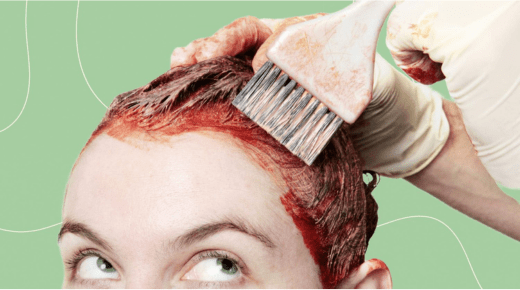1. Recognize the Symptoms
Hair dye allergies can cause symptoms such as itching, redness, swelling, and rashes on the scalp, neck, and face. In severe cases, you may experience blisters or difficulty breathing. Recognizing these symptoms early can help you take prompt action to alleviate them.
2. Perform a Patch Test
Before using any hair dye, perform a patch test. Apply a small amount of dye to a hidden area of your skin and wait 48 hours to see if there’s any reaction. This simple step can prevent a full-blown allergic reaction.
3. Immediate Rinse
If you experience an allergic reaction while dyeing your hair, rinse your scalp immediately with cool water. Thoroughly washing out the dye can help reduce the severity of the reaction by removing the allergen from your skin.
4. Use Mild Shampoo
Wash your hair with a mild, fragrance-free shampoo to remove any remaining dye. Gentle cleansing helps soothe the scalp and reduces further irritation and itching caused by the allergic reaction.
5. Cold Compress
Applying a cold compress to the affected area can help reduce itching, swelling, and redness. Wrap ice cubes in a cloth or use a cold gel pack and apply it to the irritated skin for 10-15 minutes.
6. Aloe Vera Gel
Aloe vera gel is known for its soothing and healing properties. Apply fresh aloe vera gel directly to the allergic area to reduce inflammation, itching, and redness, and to promote skin healing.
7. Coconut Oil
Coconut oil helps moisturize and soothe irritated skin. Apply a thin layer of virgin coconut oil to the affected area. Its anti-inflammatory and antimicrobial properties can help reduce symptoms and prevent infections.
8. Hydrocortisone Cream
Over-the-counter hydrocortisone cream can help reduce inflammation and itching caused by hair dye allergies. Apply a small amount to the affected area as directed on the package for quick relief.
9. Antihistamines
Taking oral antihistamines, such as cetirizine (Zyrtec) or loratadine (Claritin), can help manage allergy symptoms like itching and swelling. These medications work by blocking histamine, the substance that causes allergic reactions.
10. Avoid Scratching
Scratching the affected area can worsen the symptoms and lead to infection. Try to avoid scratching and use soothing treatments to manage itching and irritation.
11. Baking Soda Paste
Baking soda can help neutralize allergens and reduce itching. Mix baking soda with water to form a paste and apply it to the affected area. Leave it on for 10-15 minutes before rinsing off with cool water.
12. Chamomile Tea Rinse
Chamomile tea has anti-inflammatory properties that can soothe irritated skin. Brew a strong cup of chamomile tea, let it cool, and use it as a rinse for the affected area to reduce redness and itching.
13. Neem Oil
Neem oil has anti-inflammatory and antimicrobial properties that can help treat hair dye allergies. Apply a small amount of neem oil to the allergic area to reduce itching and prevent infection.
14. Apple Cider Vinegar
Apple cider vinegar can help restore the skin’s pH balance and reduce itching. Mix equal parts of apple cider vinegar and water, and apply the solution to the affected area with a cotton ball. Rinse after 10-15 minutes.
15. Tea Tree Oil
Tea tree oil has antiseptic and anti-inflammatory properties. Dilute a few drops of tea tree oil with a carrier oil like coconut oil and apply it to the allergic area to reduce itching and swelling.
16. Olive Oil
Olive oil is a natural moisturizer that can help relieve dry, itchy skin caused by hair dye allergies. Apply a small amount of extra virgin olive oil to the affected area to soothe and hydrate the skin.
17. Witch Hazel
Witch hazel is a natural astringent that can help reduce itching and inflammation. Apply witch hazel extract to the affected area with a cotton ball to soothe the skin and reduce redness.
18. Honey
Honey has natural antimicrobial and anti-inflammatory properties. Apply a thin layer of raw honey to the allergic area and leave it on for 20-30 minutes before rinsing with warm water to soothe the skin and promote healing.
19. Peppermint Oil
Peppermint oil provides a cooling sensation that can help reduce itching. Dilute a few drops of peppermint oil with a carrier oil like coconut oil and apply it to the affected area to soothe and cool the skin.
20. Calendula Cream
Calendula cream, made from marigold flowers, has healing and anti-inflammatory properties. Apply calendula cream to the affected area to help soothe the skin and promote healing.
21. Vitamin E Oil
Vitamin E oil helps repair and moisturize damaged skin. Apply a few drops of vitamin E oil to the allergic area to reduce dryness and promote healing. It is especially beneficial for treating dry, itchy skin.
22. Yogurt
Yogurt contains probiotics that help restore the skin’s natural balance. Apply plain yogurt to the affected area and leave it on for 20-30 minutes before rinsing with cool water to soothe and hydrate the skin.
23. Oatmeal Bath
An oatmeal bath can help soothe itchy, inflamed skin caused by hair dye allergies. Add one cup of finely ground oatmeal to lukewarm bathwater and soak for 15-20 minutes. Oatmeal has anti-inflammatory properties that calm the skin.
24. Fenugreek Seeds
Fenugreek seeds have anti-inflammatory properties that help soothe skin allergies. Soak fenugreek seeds in water overnight, grind them into a paste, and apply it to the affected area. Leave it on for 20-30 minutes before rinsing with cool water.
25. Avoid Hair Dye Triggers
Identify and avoid hair dyes containing common allergens like para-phenylenediamine (PPD) and ammonia. Opt for hypoallergenic or natural hair dyes, such as henna, to prevent future allergic reactions. Always perform a patch test before using a new product.





